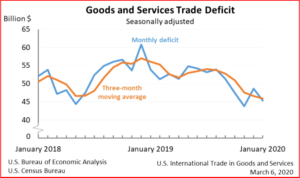
Click to Enlarge.
The US international trade deficit in goods and services may have decreased to $45.3 billion in January from $48.6 billion in December (revised), as imports decreased more than exports. However, the Census Bureau does not have sufficient statistical evidence to conclude that the actual change is different from zero.
The drop in imports portends shortages, which could harm both consumer and business spending. The coronavirus epidemic has upset businesses and production in China, with an extension of the Lunar Year holidays cutting output in an effort by the Chinese government to constrain its spread. This likely will be repeated in the US economy as the epidemic spreads here. It’s too soon to see the potential negative effects on the auto industry, but disruptions are likely given China, South Korea and Mexican trade in automotive goods.
The goods trade deficit with China increased 5.1% to $26.1 billion in January, with exports tumbling 18.7% and imports falling 1.2%.
Trade added an estimated 1.5 percentage points to GDP growth in the Q4, exceeding the 1.17 percentage points from consumer spending. However, consumer spending accounts for more two-thirds of U.S. economic activity.

About Ken Zino
Ken Zino, editor and publisher of AutoInformed, is a versatile auto industry participant with global experience spanning decades in print and broadcast journalism, as well as social media. He has automobile testing, marketing, public relations and communications experience. He is past president of The International Motor Press Assn, the Detroit Press Club, founding member and first President of the Automotive Press Assn. He is a member of APA, IMPA and the Midwest Automotive Press Assn.
He also brings an historical perspective while citing their contemporary relevance of the work of legendary auto writers such as Ken Purdy, Jim Dunne or Jerry Flint, or writers such as Red Smith, Mark Twain, Thomas Jefferson – all to bring perspective to a chaotic automotive universe.
Above all, decades after he first drove a car, Zino still revels in the sound of the exhaust as the throttle is blipped during a downshift and the driver’s rush that occurs when the entry, apex and exit points of a turn are smoothly and swiftly crossed. It’s the beginning of a perfect lap.
AutoInformed has an editorial philosophy that loves transportation machines of all kinds while promoting critical thinking about the future use of cars and trucks.
Zino builds AutoInformed from his background in automotive journalism starting at Hearst Publishing in New York City on Motor and MotorTech Magazines and car testing where he reviewed hundreds of vehicles in his decade-long stint as the Detroit Bureau Chief of Road & Track magazine. Zino has also worked in Europe, and Asia – now the largest automotive market in the world with China at its center.



Pingback: National Debt Projections – Off the Chart Before COVID-19 | AutoInformed